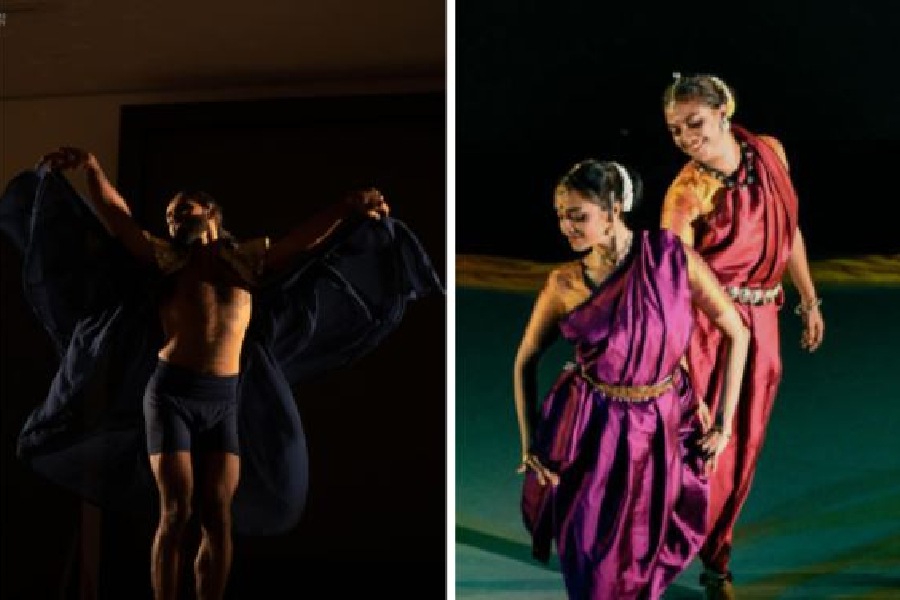Two recent performances at the Kolkata Centre for Creativity were eclectic and impressive.If one was a crackling, energetic and sassy Waacking solo of extraordinary power, the other, a presentation in Bharatnatyam and Odissi, could perhaps best be likened to a handmade lace doily of exquisite silken threads, a study in balance, proportion and beauty.
Sangram Mukhopadhyay’s Waacking Kya Hain Aap Meri Jaan Lijiye (picture, left), created as part of the KCC Art Fellowship for 2022-23, was one of the best examples this reviewer has seen of a performance drawing the audience into an experience of learning, participating and discovering. He is a crowd pleaser with a gift: music flows through his body in visual ways. Drawing upon the expressive air-chopping Waacking vocabulary to bear upon his Bollywood inheritance and South Asian queer imagination, he devises a performance that examines who he is and the context within which he chooses to situate his work. With a high-octane movement ethos, blurred gender identities, and a deep sense of social sensitivity, he attempts to look at the shape of Waacking not only as he has received it from its 50-odd years of history, originating in protest against oppression at the Los Angeles gay clubs, but also to see how it relates to where he is now.
Mukhopadhyay owned the stage with characteristic swagger and edgy aesthetics, changing costumes on stage to add significance to the roles he played. He strutted on heels with flamboyance, improvised cleverly, executed extraordinary arabesques and ended with a workshop in technique in a spirit of sharing and co-creating. His inspiration came from Rekha — indicated in the name of the performance tweaked from the song of the iconic 1981 film, Umrao Jaan — and the other prima donnas who set the screen on fire in celebrated Bollywood numbers.
Underneath his explosive and riveting action, Mukhopadhyay’s quest in this work is a pervasive one. He inquires into the possibilities of how the iconography of this American street dance form could become his own identity and expression and exist in the dance ecology of this part of the world. The fact that he left the choice of songs to his audience allowed him to demonstrate the multiple opportunities for spontaneous choreography within the Waacking technique.
The other performance, Anubhav (picture, right), presented by Taal Connect, featured the Odissi and Bharatnatyam exponents, Shashwati Garai Ghosh and Lakshmi Parthasarathy Athreya, respectively, in four succinctly detailed and tight choreographic works. The two dancers, compelling, self-possessed and virtuosic, began with Samagam, a piece choreographed by Sharmila Biswas. Marvellously intense, this work invented a gripping language comprising those of the two dance forms to connect the artists’ immersion in the ideals of rasa through unexpected reverberations.
Athreya’s Anjaneya, choreographed by Chitra Visweswaran, was a workof great poise and beauty that spokeof the devotion of Hanuman as Rama’s messenger sent in search of Sita.Garai Ghosh’s Katha Surpanakha,created by Biswas, explored themany contrasting emotions of an individual. The dancer moved with easy precision, sculpting the story ofa woman of agency, whose love for Rama and her life-changing realisations thereafter bring out the many shades in the persona of its often harshly judged protagonist. The evening ended with a Geetagovinda ashtapadi, “Sakhi hey”, presented as a fetching duet with the dancers embodying a metaphorical yearning for the sublime in the pursuit of which lifetimes are spent.











